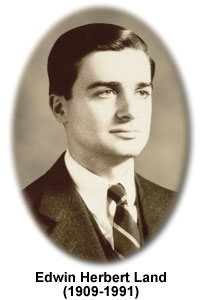Edwin Herbert Land
(1909-1991)

The founder of the Polaroid Corporation, Edwin Herbert Land was an American inventor and researcher who dedicated his entire adult life to the study of polarized light, photography and color vision. The son of a Connecticut scrap-metal dealer, Land was educated at the Norwich Free Academy and as a child slept with a copy of Robert Wood's Physical Optics under his pillow.
As a Harvard University freshman studying physics, Land sought a way to produce an inexpensive and efficient polarizer. His impetus for the endeavor was the lack of safety for nighttime pedestrians who were hit by cars because of the glare from headlights of oncoming vehicles. He soon abandoned his formal education in favor of self-directed study at the New York Public Library. Land succeeded in his quest and developed a new kind of polarizer, which he called Polaroid, in which iodoquinine sulfate crystals were aligned and embedded in a transparent plastic sheet that prevented the crystals from drifting apart. The new polarizer film, which was low cost, thin and could be cut easily to any size and shape to fit the application, was patented in 1929. Land returned to Harvard for a time to perfect his polarizer, but never graduated, although he was eventually given an honorary degree.
With his Harvard physics instructor, George Wheelwright III, Land left school for the second time to found the Land-Wheelwright Laboratories in 1932. Together they learned to make reliable, cheap polarizers and sell them for camera filters and sunglasses, and they persuaded investors of the huge potential market for polarizers to control headlight glare and view three-dimensional movies. In 1937, with help of investors, the enterprise became Polaroid Corporation, of which Land was both President and Head of Research.
The Polaroid organization was to become incredibly successful in a variety of areas. The research team was especially important for domestic defense and other military purposes. One important Polaroid design was the vectograph, which created three-dimensional images by superimposing two views of a stereoscopic picture on a single sheet of film, and is still used in aerial photography and satellite reconnaissance. Land also helped develop infrared polarizers, heat-stable filters, night-vision goggles, polarizing ring sights, and a special lens that was outfitted on the infamous U-2 spy planes. For his national security work, Land received the W.O. Baker Award, the Presidential Medal of Freedom and the National Medal of Science.
Perhaps Land's most famous contribution to science, however, was his development of instant photography. The invention was inspired by his three-year old daughter when she asked him why she could not instantly see a picture he had just taken of her on vacation. The one-step dry photographic process took Land three years to perfect, but his success was phenomenal. Geared towards the growing, post-war middle class, his instant cameras marketed for under $100 did not require much skill to use and became hugely popular. Later, with scientists in mind, Land created instant cameras for use with microscopes, telescopes, and oscilloscopes.
A lifelong interest in human color vision spurred over thirty years of Land's research. Working with various academics, he helped explain the link between vision and neurophysiology in his retinex theory and was one of the first to propose that color was a field, instead of a point, phenomenon. Land was extremely driven and inquisitive and completed numerous experiments during his studies. When Land retired as Polaroid's President in 1982, he did not rest, but founded the Rowland Institute for Science.
